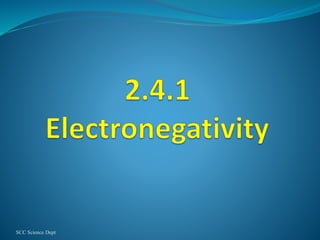2.4.1 electronegativity
•Als PPTX, PDF herunterladen•
4 gefällt mir•7,499 views
Melden
Teilen
Melden
Teilen

Empfohlen
This power point work describe about polar and nonn polar compounds and how to find it very easily and it also explain dipole moment and its calculation...this includes some workout problems Polar and non polar compounds and dipole moment - PPT

Polar and non polar compounds and dipole moment - PPTSri Ramakrishna Mission Vidyalaya College of Arts and Science,Coimbatore-20.
Weitere ähnliche Inhalte
Was ist angesagt?
This power point work describe about polar and nonn polar compounds and how to find it very easily and it also explain dipole moment and its calculation...this includes some workout problems Polar and non polar compounds and dipole moment - PPT

Polar and non polar compounds and dipole moment - PPTSri Ramakrishna Mission Vidyalaya College of Arts and Science,Coimbatore-20.
Was ist angesagt? (20)
Properties and Formation of Ionic Compounds Powerpoint

Properties and Formation of Ionic Compounds Powerpoint
Polar and non polar compounds and dipole moment - PPT

Polar and non polar compounds and dipole moment - PPT
Andere mochten auch
Andere mochten auch (20)
3 stoichiometry, formulas and equations learning outcomes

3 stoichiometry, formulas and equations learning outcomes
Ähnlich wie 2.4.1 electronegativity
Ähnlich wie 2.4.1 electronegativity (20)
Class 11 Chapter 4 Chemical Bonding and Molecular Structure.pptx

Class 11 Chapter 4 Chemical Bonding and Molecular Structure.pptx
Mehr von Martin Brown
Mehr von Martin Brown (20)
Jcsp library project Reading promotion - 10 great opening lines

Jcsp library project Reading promotion - 10 great opening lines
Jcsp library project Reading promotion - 10 great halloween reads - poster

Jcsp library project Reading promotion - 10 great halloween reads - poster
Kürzlich hochgeladen
This presentation was provided by William Mattingly of the Smithsonian Institution, during the fourth segment of the NISO training series "AI & Prompt Design." Session Four: Structured Data and Assistants, was held on April 25, 2024.Mattingly "AI & Prompt Design: Structured Data, Assistants, & RAG"

Mattingly "AI & Prompt Design: Structured Data, Assistants, & RAG"National Information Standards Organization (NISO)
Kürzlich hochgeladen (20)
Web & Social Media Analytics Previous Year Question Paper.pdf

Web & Social Media Analytics Previous Year Question Paper.pdf
Interactive Powerpoint_How to Master effective communication

Interactive Powerpoint_How to Master effective communication
Beyond the EU: DORA and NIS 2 Directive's Global Impact

Beyond the EU: DORA and NIS 2 Directive's Global Impact
Kisan Call Centre - To harness potential of ICT in Agriculture by answer farm...

Kisan Call Centre - To harness potential of ICT in Agriculture by answer farm...
Mattingly "AI & Prompt Design: Structured Data, Assistants, & RAG"

Mattingly "AI & Prompt Design: Structured Data, Assistants, & RAG"
Disha NEET Physics Guide for classes 11 and 12.pdf

Disha NEET Physics Guide for classes 11 and 12.pdf
IGNOU MSCCFT and PGDCFT Exam Question Pattern: MCFT003 Counselling and Family...

IGNOU MSCCFT and PGDCFT Exam Question Pattern: MCFT003 Counselling and Family...
2.4.1 electronegativity
- 2. Is the relative attraction that an atom in a molecule has for the shared pair of electrons in a covalent bond. In a bond between two identical atoms the pair of electrons are shared equally chemists have found that in many bonds the pair of electrons are attracted to one of the atoms more than to the other. SCC Science Dept
- 3. Hydrogen and Chlorine Electrons attracted to chlorine more than to hydrogen [ bigger , but more +ve nucleus] therefore the electrons spend more time near the chlorine than near the hydrogen this gives the chlorine a slightly negative charge [δ- delta minus] it gives the hydrogen a slightly positive charge [δ+ delta plus] SCC Science Dept
- 5. Linus Pauling measured the electronegativity of each element and put them in a table Noble gases are not in this table because they do not form bonds + SCC Science Dept H Cl –
- 6. Differences and Bond Type Difference 0 to 0.4 [Pure] Covalent Bond Difference > 0.4 but < 1.7 Polar Covalent Bond Difference is = or > 1.7 then Ionic Bond SCC Science Dept
- 7. Trends in Electronegativity Across a period Goes up Bigger nuclear charge – Smaller atomic radius distance from nucleus Actually closer as diameter of atom gets smaller – SCC Science Dept
- 8. Trends in electronegativity Down a Group Goes down Bigger nuclear charge But! But! But! But! Increased Atomic Radius - electron is much further from nucleus Increased shielding by more inner electron shells SCC Science Dept
- 9. Define electronegativity [3] 2. Who invented the term? [1] 3. What happens to it as you go across a period. Explain.[3] 4. What happens to it as you go down group? Explain. [3] 5. Give three classes of bond and electronegativity associated with each [6] 6. How can you show that a molecule is polar. [4] 7. What group of elements is not present in the table of electronegativity. Why? [2] SCC Science Dept Total = 22 1.
- 10. 1. 2. 3. 4. 5. 6. 7. Define electronegativity [3] measure of the attraction of an atom / for an electron / in a shared pair Who invented the term? [1] Linus Pauling What happens to it as you go across a period. Explain.[3] Goes up / bigger nuclear charge / same shell or decreasing atomic radius What happens to it as you go down group? Explain. [3] Goes down / further from nucleus / more shielding Give three classes of bond and electronegativity associated with each [6] 0 - 0.4 / pure covalent / 0.4 to 1.7 / polar covalent / over 1.7 / ionic How can you show that a molecule is polar. [4] Rub pen / pour stream past it / polar bends / non-polar does not bend. What group of elements is not present in the table of electronegativities. Why? [2] Noble Gases / don’t bond Total = 22 SCC Science Dept